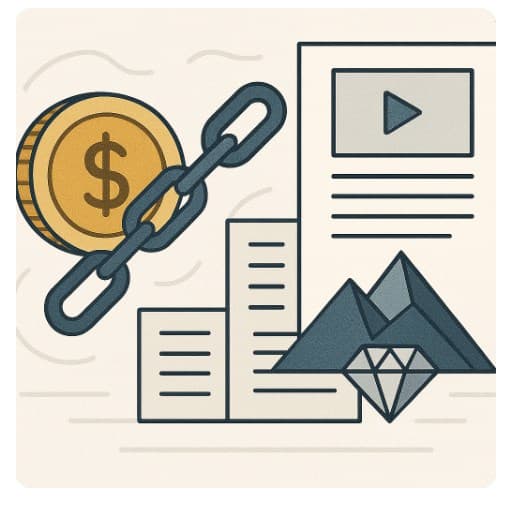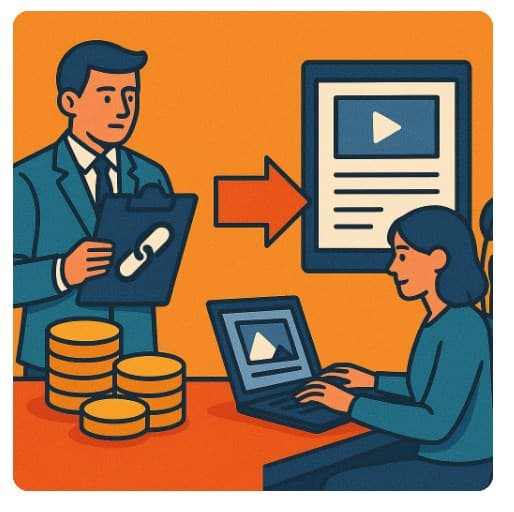Paid links offer a fast track to visibility, but this shortcut confuses a temporary spotlight with genuine authority. Building links through substantial content requires more work upfront, yet it constructs a foundation for growth that paid methods cannot match.
The core difference is simple: one is a transaction, the other is a publisher’s choice based on value.
This distinction matters deeply to search engines. Paid links also carry the risk of penalties and attract low-intent traffic. Executing a content-driven approach demands significant resources.
Ultimately, paid placements are a recurring expense, while content-driven linking builds permanent equity in your DA.

The Enduring Value of Earned Links
Think about the last time you genuinely recommended a product or article to a friend. You did it because it was helpful, not because you were paid.
That’s how earned links work. When a website links to your content, it’s a genuine recommendation. The editor makes a conscious choice because your work—be it a groundbreaking study, a comprehensive tutorial, or a unique digital tool—solves a problem for their audience.
This editorial vote carries immense weight with search engines.
It’s not just a link; it’s a signal that your site is a go-to resource within your field. This type of link doesn’t just sit on a page. It actively tells algorithms that people in your industry trust your information.
The beauty of this method is its longevity.
That one feature on a respected industry blog doesn’t expire. It continues to send signals of quality and drive interested visitors to your site for years. The work you put in today keeps paying dividends, creating a compounding effect on your site’s authority. It’s the difference between planting a tree that grows every year and renting a plastic plant you have to return.
The True Price Tag of Paid Links
Looking only at the invoice for a paid link is like judging an iceberg by its tip. The real costs lie beneath the surface. Google’s webmaster guidelines aren’t subtle about paid links designed to manipulate rankings. The consequence isn’t a gentle nudge down the results page; it can be a steep, sudden drop into obscurity. Some sites never fully recover from that kind of algorithmic penalty.
But let’s say you avoid a penalty. You still face the problem of empty clicks.
A link on a site with no relevance to your niche brings visitors who have zero reason to care about your business. They arrive confused and leave immediately. You’re essentially paying for window shoppers from the wrong town.
The metric might show a click, but it delivers no conversation, no connection, and certainly no customer. That’s a poor return by any measure.
The Strategic Shift: Building Assets, Not Just Links
The work begins when you start thinking about becoming linkable. This means shifting your energy from outreach to creation. Instead of asking “who will link to us?”, the question becomes “what can we create that deserves a link?”
This looks like spotting what’s missing in your industry’s conversation. Maybe it’s a definitive guide that pulls together scattered information, or an original survey that provides fresh data everyone wants to cite. You’re not just creating content; you’re building a resource library that positions your brand as a primary source.
This work is deep.
It needs skilled writers who understand nuance, researchers who can find the story in the data, and persistent outreach specialists who know how to connect with publishers. For a business focused on its own products and customers, this can stretch internal teams thin.
This is where a dedicated link outreach agency like Linkbuilding.services fits in. They handle the entire lifecycle, from identifying the right opportunity to creating the asset and managing the publisher relationships. That way, they turn a complex, time-consuming project into a streamlined operation.
The Ripple Effect of Credibility
There’s a secondary benefit to content-earned links that rarely gets mentioned: market perception. When a potential customer finds your brand mentioned in a publication they trust, it does more than just bring a click. It transfers a piece of that publication’s credibility to your business. After all, you’re a company that Industry Insider or Local Business Journal found noteworthy.
This effect is impossible to buy.
A paid link is just an ad, and visitors recognize it as such. But an organic mention within a legitimate article carries the weight of a third-party endorsement. It shortens the customer’s journey from discovery to trust. They arrive with a baseline level of confidence because a source they already value has effectively vouched for you.
This builds brand authority in a way that paid placements simply cannot replicate, making your marketing efforts work harder long after the initial link is secured.

Final Thoughts
Your linking strategy ultimately comes down to a simple financial analogy. Paid links are a lease agreement. You make regular payments to occupy a space, but you build no equity. The moment you stop paying, your presence vanishes.
Content-driven link building is the process of buying property.
The initial investment is higher, but you acquire a permanent asset. Each piece of content that earns a link adds a brick to your foundation, permanently increasing your domain’s value and authority. In the long run, owning your search presence will always outperform renting it.
